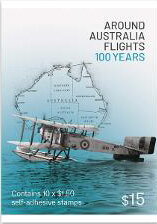Booklet: First Circum-Australia Flight, Centenary (Australia 2024)
First Circum-Australia Flight, Centenary (Australia 2024)
21 May (Australia ) within release First Circum-Australia Flight, Centenary (2024) goes into circulation Booklet First Circum-Australia Flight, Centenary face value 10*1.50 Australian dollar
| Booklet First Circum-Australia Flight, Centenary in catalogues | |
|---|---|
| Colnect codes: | Col: AU 2024.05.21-02c |
Booklet is square format.
Also in the issue First Circum-Australia Flight, Centenary (2024):
- Stamp - De Havilland D.H.50 G-AUAB face value 1.50;
- Stamp - De Havilland D.H.50 G-AUAB face value 1.50;
- Stamp - Fairey IIID Seaplane A10-3 face value 1.50;
- Stamp - Fairey IIID Seaplane A10-3 face value 1.50;
- Se-tenant - First Circum-Australia Flight, Centenary face value 2*1.50;
- Se-tenant - First Circum-Australia Flight, Centenary face value 2*1.50;
- Booklet - First Circum-Australia Flight, Centenary face value 10*1.50;
Booklet First Circum-Australia Flight, Centenary it reflects the thematic directions:
An aircraft (pl. aircraft) is a vehicle that is able to fly by gaining support from the air. It counters the force of gravity by using either static lift or the dynamic lift of an airfoil, or, in a few cases, direct downward thrust from its engines. Common examples of aircraft include airplanes, rotorcraft (including helicopters), airships (including blimps), gliders, paramotors, and hot air balloons.Part 1 (Definitions and Abbreviations) of Subchapter A of Chapter I of Title 14 of the U. S. Code of Federal Regulations states that aircraft "means a device that is used or intended to be used for flight in the air."
An anniversary is the date on which an event took place or an institution was founded in a previous year, and may also refer to the commemoration or celebration of that event. For example, the first event is the initial occurrence or, if planned, the inaugural of the event. One year later would be the first anniversary of that event. The word was first used for Catholic feasts to commemorate saints. Most countries celebrate national anniversaries, typically called national days. These could be the date of independence of the nation or the adoption of a new constitution or form of government. The important dates in a sitting monarch's reign may also be commemorated, an event often referred to as a "Jubilee".
Aviation is the practical aspect or art of aeronautics, being the design, development, production, operation and use of aircraft, especially heavier than air aircraft. The word aviation was coined by French writer and former naval officer Gabriel La Landelle in 1863, from the verb avier (synonymous flying), itself derived from the Latin word avis ("bird") and the suffix -ation.
A map is a symbolic depiction emphasizing relationships between elements of some space, such as objects, regions, or themes. Many maps are static, fixed to paper or some other durable medium, while others are dynamic or interactive. Although most commonly used to depict geography, maps may represent any space, real or imagined, without regard to context or scale, such as in brain mapping, DNA mapping, or computer network topology mapping. The space being mapped may be two dimensional, such as the surface of the earth, three dimensional, such as the interior of the earth, or even more abstract spaces of any dimension, such as arise in modeling phenomena having many independent variables. Although the earliest maps known are of the heavens, geographic maps of territory have a very long tradition and exist from ancient times. The word "map" comes from the medieval Latin Mappa mundi, wherein mappa meant napkin or cloth and mundi the world. Thus, "map" became the shortened term referring to a two-dimensional representation of the surface of the world.




